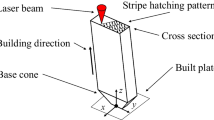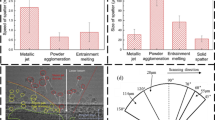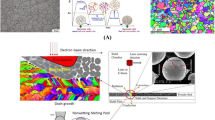Abstract
Fine and cohesive powders typically exhibit low packing density, with solid volume fraction around 0.3. Discrete element modelling (DEM) of particulate materials and processes typically employs spherical particles which have much larger solid fractions (e.g. 0.64 for dense random packing of frictionless spheres). In this work a range of quasi-spherical particles are designed, represented by a number of small satellites connected rigidly to a larger centre sphere. Using DEM, packing density is found to be controlled by the interplay between particle shape, size and inter-particle cohesion and friction. Low packing density is obtained for an appropriate combination of (1) particle shape that allows the creation of geometrically loose structures via separation of the central particles by the satellites, (2) particle size that should be sufficiently small so that adhesive forces between particles become dominant over gravity, (3) adhesive forces, determined from surface energy, should be sufficiently large, and (4) friction (static friction was found to have a dominant role compared to rolling friction, but negligible compared to adhesive forces for small particle size). By using the proposed quasi-spherical particle designs it becomes possible to calibrate more realistic DEM models for particulate processes that reproduces not only packing, but also other behaviours of bulk powders.
















Similar content being viewed by others
References
German RM (1989) Particle packing characteristics. Metal Powder Industries Federation
White HE, Walton SF (1937) Particle packing and particle shape. J Am Ceram Soc 20(1–12):155–166
Allen JRL (ed) (1982) Chapter 4 packing of sedimentary particles, in developments in sedimentology. Elsevier, Amsterdam, pp 137–177
Rothon RN (2003) Particulate-filled polymer composites. Rapra Technology Limited, Shrewsbury
Dias R et al (2004) Particulate binary mixtures: dependence of packing porosity on particle size ratio. Ind Eng Chem Res 43(24):7912–7919
Sohn HY, Moreland C (1968) The effect of particle size distribution on packing density. Can J Chem Eng 46(3):162–167
Ye X et al (2018) Novel powder packing theory with bimodal particle size distribution-application in superalloy. Adv Powder Technol 29(9):2280–2287
Farr R, Groot R (2009) Close packing density of polydisperse hard spheres. J Chem Phys 131:244104
Krupp H (1967) Particle adhesion theory and experiment. Adv Colloid Interface Sci 1(2):111–239
Yu AB, Bridgwater J, Burbidge A (1997) On the modelling of the packing of fine particles. Powder Technol 92(3):185–194
Visser J (1989) Van der Waals and other cohesive forces affecting powder fluidization. Powder Technol 58(1):1–10
Bruni G (2005) An investigation of the influence of fines size distribution and high temperature on the fluidization behaviour of gas fluidized beds linked with rheological studies. Department of Chemical Engineering, University College London, London
Yu AB, Standish N, Lu L (1995) Coal agglomeration and its effect on bulk density. Powder Technol 82(2):177–189
Holubec I, D'Appolonia E (1973) Effect of particle shape on the engineering properties of granular soils. American Society for Testing and Materials, West Conshohocken
Youd TL (1973) Factors controlling maximum and minimum densities of sands. Evaluation of relative density and its role in geotechnical projects involving cohesion less soils (523)
Rouse P, Fannin RJ, Shuttle DA (2008) Influence of roundness on the void ratio and strength of uniform sand. Geotechnique 58:227–231
Cho G-C, Dodds J, Santamarina J (2006) Particle shape effects on packing density, stiffness, and strength: natural and crushed sands. Geotechn Geoenviron Eng 132(5):591–602
Nolan GT, Kavanagh PE (1995) Random packing of nonspherical particles. Powder Technol 84(3):199–205
Yang RY, Zou RP, Yu AB (2003) Effect of material properties on the packing of fine particles. J Appl Phys 94:3025–3034
Kallus Y (2016) The random packing density of nearly spherical particles. Soft Matter 12(18):4123–4128
Baserinia R, Sinka IC (2018) Mass flow rate of fine and cohesive powders under differential air pressure. Powder Technol 334:173–182
Marigo M, Stitt EH (2015) Discrete element method (DEM) for industrial applications: comments on calibration and validation for the modelling of cylindrical pellets. KONA Powder Part J 32:236–252
Ketterhagen WR, Ende MT, Hancock BC (2009) Process modeling in the pharmaceutical industry using the discrete element method. J Pharm Sci 98(2):442–470
Gantt JA, Gatzke EP (2005) High-shear granulation modeling using a discrete element simulation approach. Powder Technol 156(2):195–212
Hassanpour A et al (2009) Effect of granulation scale-up on the strength of granules. Powder Technol 189(2):304–312
Wu C-Y (2008) DEM simulations of die filling during pharmaceutical tabletting. Particuology 6(6):412–418
Guo Y et al (2010) Numerical analysis of density-induced segregation during die filling. Powder Technol 197(1):111–119
Cleary PW, Sawley ML (2002) DEM modelling of industrial granular flows: 3D case studies and the effect of particle shape on hopper discharge. Appl Math Modelling 26(2):89–111
Anand A et al (2008) Predicting discharge dynamics from a rectangular hopper using the discrete element method (DEM). Chem Eng Sci 63(24):5821–5830
Ketterhagen WR et al (2009) Predicting the flow mode from hoppers using the discrete element method. Powder Technol 195(1):1–10
Arratia PE et al (2006) A study of the mixing and segregation mechanisms in the Bohle Tote blender via DEM simulations. Powder Technol 164(1):50–57
Xu Y et al (2010) 2D DEM simulation of particle mixing in rotating drum: a parametric study. Particuology 8(2):141–149
Alizadeh E, Bertrand F, Chaouki J (2014) Discrete element simulation of particle mixing and segregation in a tetrapodal blender. Comput Chem Eng 64:1–12
Zhang ZP et al (2001) A simulation study of the effects of dynamic variables on the packing of spheres. Powder Technol 116(1):23–32
Gan JQ, Yu AB, Zhou ZY (2016) DEM simulation on the packing of fine ellipsoids. Chem Eng Sci 156:64–76
Cundall PA, Strack O (1979) A discrete numerical mode for granular assemblies. Geotechnique 29:47–65
Tanaka K et al (2001) Numerical and experimental studies for the impact of projectiles on granular materials. In: Levy A, Kalman H (eds) Handbook of powder technology. Elsevier, Amsterdam, pp 263–270
Wills BA, Finch JA (2016) Chapter 17—modeling and characterization. In: Wills BA, Finch JA (eds) Wills' mineral processing technology, 8th edn. Butterworth-Heinemann, Boston, pp 449–462
Fortin J, Millet O, Saxcé GD (2004) Numerical simulation of granular materials by an improved discrete element method. Int J Numer Methods Eng 62:639–663
Mindlin RD (1949) Compliance of elastic bodies in contact. Trans ASME J Appl Mech 16:259–268
Hertz H (1982) Über die Berührung fester elastischer Körper. Journal für die Reine und Angewandte Mathematik 92:156–171
Johnson KL, Kendall K, Roberts AD (1971) Surface energy and contact of elastic solids. Proc R Soc Lond A Math Phys Sci 324:301–313
Mishra BK, Thornton C, Bhimji D (2002) A preliminary numerical investigation of agglomeration in a rotary drum. Miner Eng 15(1):27–33
Li SQ, Marshall JS (2007) Discrete element simulation of micro-particle deposition on a cylindrical fiber in an array. J Aerosol Sci 38(10):1031–1046
Barthel E (2008) Adhesive elastic contacts: JKR and more. J Phys D Appl Phys 41(16):163001
Deng X, Scicolone JV, Davé RN (2013) Discrete element method simulation of cohesive particles mixing under magnetically assisted impaction. Powder Technol 243:96–109
Deng XL, Davé RN (2013) Dynamic simulation of particle packing influenced by size, aspect ratio and surface energy. Granular Matter 15(4):401–415
Cabiscol R, Finke JH, Kwade A (2018) Calibration and interpretation of DEM parameters for simulations of cylindrical tablets with multi-sphere approach. Powder Technol 327:232–245
Asaf Z, Rubinstein D, Shmulevich I (2007) Determination of discrete element model parameters required for soil tillage. Soil Tillage Res 92(1):227–242
Coetzee CJ (2017) Review: calibration of the discrete element method. Powder Technol 310:104–142
Coetzee CJ (2019) Particle upscaling: calibration and validation of the discrete element method. Powder Technol 344:487–503
Fangping Y et al (2019) Calibration and verification of DEM parameters for dynamic particle flow conditions using a backpropagation neural network. Adv Powder Technol 30(2):292–301
Roessler T, Katterfeld A (2019) DEM parameter calibration of cohesive bulk materials using a simple angle of repose test. Particuology 45:105–115
Boikov A, Savelev R, Payor V (2018) DEM calibration approach: random forest. J Phys 1118:012009
Coetzee CJ (2016) Calibration of the discrete element method and the effect of particle shape. Powder Technol 297:50–70
Do HQ, Aragón AM, Schott DL (2018) A calibration framework for discrete element model parameters using genetic algorithms. Adv Powder Technol 29(6):1393–1403
Baroutaji A et al (2017) Mechanics and computational modeling of pharmaceutical tabletting process. In: Reference module in materials science and materials engineering. Elsevier, Amsterdam
Lemieux M et al (2008) Large-scale numerical investigation of solids mixing in a V-blender using the discrete element method. Powder Technol 181(2):205–216
Bertrand F, Leclaire LA, Levecque G (2005) DEM-based models for the mixing of granular materials. Chem Eng Sci 60(8):2517–2531
Roskilly SJ et al (2010) Investigating the effect of shape on particle segregation using a Monte Carlo simulation. Powder Technol 203(2):211–222
Miyajima T, Yamamoto K-I, Sugimoto M (2001) Effect of particle shape on packing properties during tapping. Adv Powder Technol 12(1):117–134
Zhao S et al (2017) Particle shape effects on fabric of granular random packing. Powder Technol 310:175–186
Anikeenko AV, Medvedev NN (2007) Polytetrahedral nature of the dense disordered packings of hard spheres. Phys Rev Lett 98(23):235504
Klumov BA, Khrapak SA, Morfill GE (2011) Structural properties of dense hard sphere packings. Phys Rev B 83(18):184105
Onoda GY, Liniger EG (1990) Random loose packings of uniform spheres and the dilatancy onset. Phys Rev Lett 64(22):2727–2730
Jerkins M et al (2008) Onset of mechanical stability in random packings of frictional spheres. Phys Rev Lett 101(1):018301
Farrell GR, Martini KM, Menon N (2010) Loose packings of frictional spheres. Soft Matter 6:2925–2930
Kloss C et al (2012) Models, algorithms and validation for opensource DEM and CFD-DEM. Prog Comput Fluid Dyn Int J 12(2/3):140
Garcia X et al (2009) A clustered overlapping sphere algorithm to represent real particles in discrete element modelling. Géotechnique. 59(9):779–784
Lu G, Third JR, Müller CR (2015) Discrete element models for non-spherical particle systems: from theoretical developments to applications. Chem Eng Sci 127:425–465
You Y, Zhao Y (2018) Discrete element modelling of ellipsoidal particles using super-ellipsoids and multi-spheres: a comparative study. Powder Technol 331:179–191
He Y et al (2018) Discrete modelling of the compaction of non-spherical particles using a multi-sphere approach. Miner Eng 117:108–116
Seelen LJH, Padding JT, Kuipers JAM (2018) A granular discrete element method for arbitrary convex particle shapes: method and packing generation. Chem Eng Sci 189:84–101
Tahmasebi P (2018) Packing of discrete and irregular particles. Comput Geotech 100:52–61
Majidi B et al (2015) Packing density of irregular shape particles: DEM simulations applied to anode-grade coke aggregates. Adv Powder Technol 26(4):1256–1262
Gan JQ, Zhou ZY, Yu AB (2017) Interparticle force analysis on the packing of fine ellipsoids. Powder Technol 320:610–624
Tangri H, Guo Y, Curtis JS (2017) Packing of cylindrical particles: DEM simulations and experimental measurements. Powder Technol 317:72–82
Parteli EJR et al (2014) Attractive particle interaction forces and packing density of fine glass powders. Sci Rep 4:6227–6227
Liu W et al (2015) Adhesive loose packings of small dry particles. Soft Matter 11(32):6492–6498
Liu W et al (2017) Effects of hydrodynamic interaction on random adhesive loose packings of micron-sized particles. EPJ Web Conf 140:08017
Elmsahli HS, Sinka IC (2019) Coupled CFD-DEM analysis of mass flow rate of fine and cohesive powders under differential air pressure. Int J Solids Struct. Manuscript submitted 2 November 2019, under review
Thornton C, Cummins SJ, Cleary PW (2013) An investigation of the comparative behaviour of alternative contact force models during inelastic collisions. Powder Technol 233:30–46
Elmsahli HSM (2019) Numerical analysis of powder flow using computational fluid dynamics coupled with discrete element modelling. Ph.D. Thesis, University of Leicester
Rhodes M (2008) Introduction to particle technology. Wiley, Great Britain
Ho R et al (2010) Determination of surface heterogeneity of d-mannitol by sessile drop contact angle and finite concentration inverse gas chromatography. Int J Pharm 387(1–2):79–86
Karde V, Ghoroi C (2014) Influence of surface modification on wettability and surface energy characteristics of pharmaceutical excipient powders. Int J Pharm 475(1–2):351–363
Acknowledgements
H.E. would like to thank Aljabal Algharbi University in Libya/Faculty of Engineering, Jadu, for presenting him with the opportunity to complete his Ph.D. He is also grateful to Libyan Cultural Affair in London for all the support and assistance given to him during his Ph.D. studies.
Author information
Authors and Affiliations
Corresponding author
Ethics declarations
Conflict of interest
On behalf of all authors, the corresponding author states that there is no conflict of interest.
Additional information
Publisher's Note
Springer Nature remains neutral with regard to jurisdictional claims in published maps and institutional affiliations.
Rights and permissions
About this article
Cite this article
Elmsahli, H.S., Sinka, I.C. A discrete element study of the effect of particle shape on packing density of fine and cohesive powders. Comp. Part. Mech. 8, 183–200 (2021). https://doi.org/10.1007/s40571-020-00322-9
Received:
Revised:
Accepted:
Published:
Issue Date:
DOI: https://doi.org/10.1007/s40571-020-00322-9




